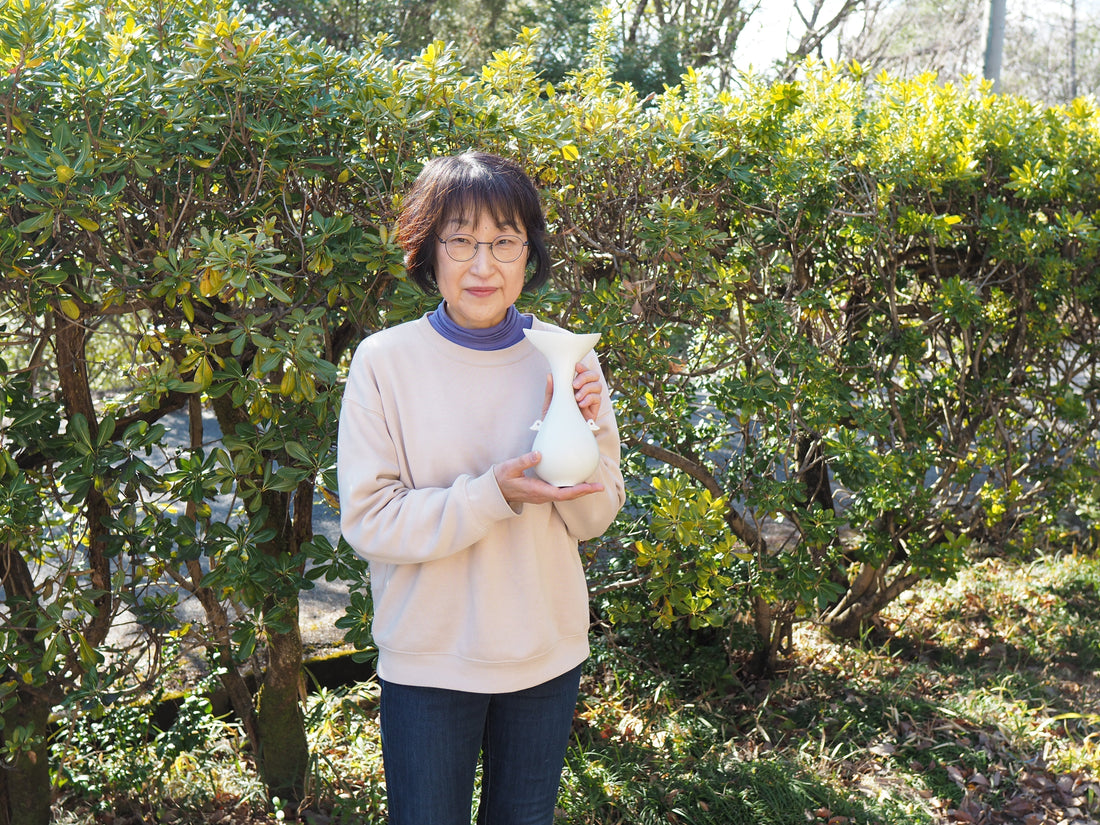
Interview with Reiko Hosokawa of Suisho Kiln
The beauty of "Kasumi Hakuji" created by a shift to porcelain and unique techniques
Profile/Ceramics history
(Hosokawa Reiko)
- 1959
- Born in Kamakura, Kanagawa Prefecture
- 1981
- Graduated from Musashino Art University, Department of Ceramic Design
- 1983
- After graduating from the Tajimi City Ceramic Design Institute, he worked as a designer at a ceramics trading company and studied under the ceramic artists Kato Kai and Reikichi from Seto City, Aichi Prefecture.
- 1995
- Became independent and built the "Suisho Kiln" in Izumicho, Toki City, Gifu Prefecture. Became a director of the Mino Ceramic Art Association, a member of the Toki City Ceramic Art Association, a friend of the Nitten Exhibition, and a member of the Nihon Kogyo.
- 1997
- First time selected for the Nitten exhibition (11 times since then as of 2024)
- 1998
- Selected for the Asahi Ceramic Art Exhibition
- 2012
- Selected for Takaoka Craft Exhibition
- 2014
- Received the Encouragement Award at the Contemporary Tea Ceremony Exhibition
- 2015
- Received the Chunichi Encouragement Award at the Mino Ceramic Art Exhibition
- 2016
- Selected for Hagi Grand Prize Exhibition IV
- 2017
- Received the T-san Award for Female Ceramic Artists
- 2021
- Received the Gifu Prefecture Traditional Culture Successor Award
- 2023
- Received the Nitten Tokai CBC Award and the 41st Takuo Award
- 2024
- Selected for ceramics exhibition
The property is located on a quiet hill about 10 minutes north of JR Tokishi Station. Looking into the property from the road, you can see various objects of different colors and shapes placed haphazardly at the base of the plants in the garden and at the entrance. Stepping inside, a large amount of "white" jumps out at you. We visited the studio of ceramic artist Reiko Hosokawa, where her works are lined up, from small vessels to impressively large objects.
Encounter with pottery and the path to independence
Reiko first encountered pottery in high school, accompanying her older sister on a pottery workshop. At first, she only made small bowls by hand twice a month, but she became fascinated by the feel of the clay and the excitement of seeing her creations being fired, and a desire to do more began to grow.
She went on to study ceramic design at Musashino Art University, where she learned about small-batch, handmade tableware in a craft design style. During her time at the university, she had the opportunity to work with not only pottery but also porcelain in her free-form projects, and she realized the difficulty and charm of both.
Wanting to continue studying traditional pottery after graduating from university, Reiko visited production areas and schools all over Japan, including Shigaraki, Kyoto, and Seto. Looking back, she says that out of all the places she visited, "it was the most welcoming environment," and so she went on to study at the Tajimi Ceramic Design Institute.
At the time, the eastern Mino region was accepting people from other regions through group employment programs, and Mino ware, which brings together ceramics from a wide range of fields including building materials in addition to tableware, was an environment with many technical advantages. Reiko recalls that her decision to move there at the time, sensing the diversity of the area, was the right one.
During his two years at school, he acquired knowledge and skills in ceramics, and after graduating, he got a job as a designer at a ceramics trading company in Tajimi City. After that, he decided to devote himself to creating his own works.
Reiko began studying under Kato Kai and Reikichi of Seto City, Aichi Prefecture, after she got married and when her child was just over one year old. "My husband understood that I wanted to continue pottery after we got married, but my child was still small and I was so busy with housework, nursery school, and pottery making that I don't remember much," she recalls.
It was during this time that she was encouraged to try her hand at large-scale works and enter them in public exhibitions. Reiko says she thought that objects were "something to look at," not something to make. Though she was hesitant, she gradually made her works larger, and eventually began to win and receive awards at public exhibitions. She decided to go independent and built the "Suisho Kiln," named after the place in Toki City, Gifu Prefecture.

The shift to porcelain
Reiko had always had a passion for porcelain, and began working with it in earnest in 2010.
Up until that point, he had acquired the skills to create the shapes he wanted in pottery, but he felt that "even if I continued to make pottery, I wasn't discovering anything new within myself." Having long had a desire to one day turn to porcelain, and having reached the age of 50, he decided to make a complete switch to porcelain, thinking, "I want to complete a porcelain piece that satisfies me before I die, and now is still a good time to try."
However, porcelain is technically more difficult than pottery, and it took a lot of trial and error.
Unlike pottery, which is made from clay-like soil, porcelain is made by turning powdered stone into a clay-like substance, which means it is prone to crumbling and deformation when made on a potter's wheel. Also, because the firing temperature is high, shapes that can withstand lower temperatures tend to crumble at higher temperatures. Despite the many unexpected challenges that come with producing pottery, Reiko continues to explore her own unique techniques, driven by her strong desire to "make porcelain pieces."
When creating large objects, if all the steps are done by hand, hand marks will appear and the finished product will not be beautiful. Furthermore, using only a potter's wheel makes the piece prone to crumbling, which is also not suitable for large objects. Casting makes the piece heavy, so Reiko doesn't have the strength to do it, and says, "I just don't like it." After much trial and error, she developed a technique in which the bottom part of the piece, which forms the base of the piece, is turned on the potter's wheel, and then the top part is added by hand in strings of clay, which gives a "fluctuating softness" to porcelain pieces, which tend to have a cold impression .

The porcelain production process
They also pay particular attention to the finishing process after firing, and for "Kasumi Hakuji" they use the shades of one type of glaze to create a unique look that resembles a mottled pattern. Also, the transparent, cracked blue and green glow that accumulates in the tea puddle (inner bottom) of the smaller vessels is achieved by layering a glassy glaze called "Hariyuu". These glazes are not commercially available glazes that are used as is, but rather original blends are added to create unique colors.
When making porcelain, which cannot be altered, she draws many "doodle-like" sketches to give form to her image, and then makes small clay models to turn the two-dimensional pieces into three-dimensional pieces. Because she tries out various things and only begins the actual production once the design has solidified, Reiko says, "The process before making takes more time."
The studio is lined with many measuring tools that Reiko made herself, as well as many small tools for shaping at different stages, such as rubber spatulas, wooden trowels, and carbide planes.She also tries out anything that seems usable even if it's not for pottery, such as sandpaper, plastic bottle caps, and wire mesh sponges.

Style and inspiration
Many of Reiko's works are based on the beauty of nature, and she particularly values a "clean and dignified appearance." For example, rather than simply depicting actual birds or plants, such as the fleeting silhouette of a kingfisher, the way the stems of a water hibiscus grow out of the water, or the sparkle of water droplets on the leaves, she abstractly expresses the "atmosphere and atmosphere of the place ." Her sources of inspiration include beautiful landscapes she finds while walking, the rippling surface of the water, and her love of reading, which she describes as "addicted to reading."
For the 10 years since he switched to porcelain, he was unable to create the works he wanted, and it was a difficult time as he was not able to win any public exhibitions. He said that he sometimes wondered, "Am I really going to be able to create my own work after going through so much effort?" However, he says that he could not let go of the joy of creating his works and the interest in seeing each piece have a slightly different expression.
It was her continued challenge to create new works that led to high acclaim for her work as an artist, including not only winning awards at public exhibitions, but also being selected for the Mino Ceramic Art Long-Term Preservation Project and receiving the Gifu Prefecture Traditional Culture Successor Award. Reiko calmly recounts that it was particularly encouraging to have her work recognized by respected artists who served as judges.

Future outlook
Reiko says, "I want to pursue colors and shapes that are suitable for making porcelain." She is particular about white porcelain and pale blue porcelain, and is currently experimenting with new colored glazes such as purple, cherry blossom, and ink to bring out the best in these wares, while searching for shapes that match these tones. She aims to create works that are not simply different colors, but "pieces in which color and shape harmonize." She will continue to submit her works to public exhibitions, and is also eager to hold a solo exhibition. She will continue to pursue the "essential beauty" of porcelain until she is satisfied, and her works, which she says she wants to continue creating until she is 100 years old, will no doubt continue to evolve even further.
(March 2025, Interview: Chika Shimura)
information
crystal kiln
1417-111, Izumicho, Toki City, Gifu Prefecture, 509-5142




